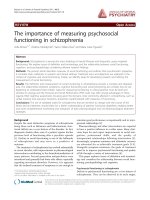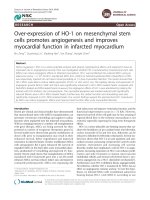Báo cáo y học: "The Importance of the Discourse on the Method" doc
Bạn đang xem bản rút gọn của tài liệu. Xem và tải ngay bản đầy đủ của tài liệu tại đây (159.69 KB, 2 trang )
EDI T O R I A L Open Access
The Importance of the Discourse on the Method
Benedetto Vitiello
*
Central to the research enterprise is the application of
scientific met hods appropriate to achieving the investi-
gational aims. In the case of controlled clinical trials,
assay sensitivity is achieved through careful selection of
study sample, design, and assessment instruments.
Treatments and controls must be precisely defined and
quantified. C oncomitant interventions need to be speci-
fied and delimited. The actual implementation of the
protocol requires procedures for ensuring fidelity, con-
sistency, and reproducibility. Typically, a clinical trial
protocol is the result of contributions from experts in
clinical care, experimental methodology, bioethics, sta-
tistics, and data management.
Appreciating the research methodology of a study is
critical for understanding the value and t he limitations
of the results. The quality of methods is especially
important in the case of so called “negative” trials, as
are often called studies that, though designed to reject a
null hypothesis of equivalence, do not find sign ificant
differences between treatments . Distinguishing a truly
negative trial (i.e., a study indicating that no difference
between treatments actually exists) from a “failed trial”
(i.e., a study that lacks assay sensitivity and is unable to
detect a difference even if it exists) depends primarily
on the strength of the research methodology of the trial.
While considerable effort usually goes into preparing
the methods for a controlled clinical trial, only a fraction
of this work is actually mentioned in the publication of
the results. There are several reasons for this situation.
First, space limitations prevent a detailed description of
the methodo logy and a critical discussion of t he theore-
tical and practical reasons for the choices that were
made vis-à-vis the possible alternatives. Second, though
the interpretation of the results hinges on a thorough
understanding of the methods that were used, many
readers of scientific literature would not have the time
of entering into these details. Lastly, in order to appreci-
ate the methodological structure behind a research
study, one needs to have some basic expertise in it,
something that not all the consumers of clinical research
actually have.
However, a more detailed sharing of clinical trial
methods than is commonly done in the typical publica-
tion of the study results is valuable from a number of
perspectives. Researchers reading their colleagues’ work
can have the opportunity of appreciating the elements
of the study and understanding the rationale for choos-
ing a particular design and specific measurements. Even
if al l clinical trials share a common experimental basis,
there c an be also considerable innovation un derway, at
the level of design, sample selection, measurement tools,
bioethical assessment, and statistical analyses [1,2]. It is
fair to say that, regardless of any standardization of
design, treatments and assessment tools, many clinical
trials have unique features regarding their methods and/
or their implementation. More detailed descriptions of
study methods and critical discussions of their strengths
and limitations can foster the development of more sen-
sitive, valid, efficient, and ultimately informative clinical
research. Finally, publishing the study methodology
separately and in advance of the results papers offers
the authors the practical benefit of being able to refer
the readers to a detailed description of the study back-
ground when reporting the results.
In recent years, a movement t owards publishing
design and methods considerations separately from the
result reports has occurred both in adult and child psy-
chiatry [3-6]. The report by Compton et al., published
in CAPMH this month, outlines t he rationale, design,
and methods of the Child/Adolescent Anxiety Multimo-
dal Study (CAMS) [7], and provides another example of
how this type of papers can help us better understand
and appreciate the results of clinical trials. Along these
lines, CAPMH welcomes the submission of similar
manuscripts describing and discussing the methodologi-
cal aspects of clinical trials in child and adolescent men-
tal health.
Acknowledgements
The opinions and assertions contained in this report are the private views of
the author and are not to be construed as official or as reflecting the views
* Correspondence:
Child and Adolescent Treatment and Preventive Intervention Research
Branch, National Institute of Mental Health, Bethesda, Maryland, USA
Vitiello Child and Adolescent Psychiatry and Mental Health 2010, 4:2
/>© 2010 Vitiello; licensee BioMed Central Ltd. This is an Open Access article distributed under the terms of the Creative Commons
Attribution License ( which permits unrestricted use, distribution, and reproduction in
any med ium, provided the original work is properly cited.
of the U.S. Department of Health and Human Services, the National
Institutes of Health, or the National Institute of Mental Health.
Received: 10 December 2009
Accepted: 7 January 2010 Published: 7 January 2010
References
1. Lavori PW, Rush AJ, Wisniewski SR, Alpert J, Fava M, Kupfer DJ,
Nierenberg A, Quitkin FM, Sackeim HA, Thase ME, Trivedi M: Strengthening
clinical effectiveness trials: equipoise-stratified randomization. Biol
Psychiatry 2001, 50:792-801.
2. Murphy SA, Lynch KG, Oslin D, McKay JR, TenHave T: Developing adaptive
treatment strategies in substance abuse research. Drug Alcohol Depend
2007, 88(Suppl 2):S24-30.
3. Rush AJ, Fava M, Wisniewski SR, Lavori PW, Trivedi MH, Sackeim HA,
Thase ME, Nierenberg AA, Quitkin FM, Kashner TM, Kupfer DJ,
Rosenbaum JF, Alpert J, Stewart JW, McGrath PJ, Biggs MM, Shores-
Wilson K, Lebowitz BD, Ritz L, Niederehe G, STAR*D Investigators Group:
Sequenced treatment alternatives to relieve depression (STAR*D):
rationale and design. Control Clin Trials 2004, 25:119-142.
4. Treatment for Adolescents with Depression Study Team: The Treatment for
Adolescents with Depression Study (TADS): rationale, design, and
methods. J Am Acad Child Adolesc Psychiatry 2003, 42:531-542.
5. McClellan J, Sikich L, Findling RL, Frazier JA, Vitiello B, Hlastala SA,
Williams E, Ambler D, Hunt-Harrison T, Maloney AE, Ritz L, Anderson R,
Hamer RM, Lieberman JA: Treatment of early-onset schizophrenia
spectrum disorders (TEOSS): rationale, design, and methods. J Am Acad
Child Adolesc Psychiatry 2007, 46:969-978.
6. Freeman JB, Choate-Summers ML, Garcia AM, Moore PS, Sapyta JJ,
Khanna MS, March JS, Foa EB, Franklin ME: The Pediatric Obsessive-
Compulsive Disorder Treatment Study II: rationale, design and methods.
Child Adolesc Psychiatry Ment Health 2009, 30(3):4.
7. Compton SN, Walkup JT, Albano AM, Piacentini JC, Birmaher B, Sherrill JT,
Ginsburg GS, Rynn MA, McCracken JT, Waslick BD, Iyengar S, Kendall PC,
March JS: Child/Adolescent Anxiety Multimodal Study (CAMS): rationale,
design, and methods. Child Adolesc Psychiatry Ment Health 2009.
doi:10.1186/1753-2000-4-2
Cite this article as: Vitiello: The Importance of the Discourse on the
Method. Child and Adolescent Psychiatry and Mental Health 2010 4 :2.
Publish with BioMed Central and every
scientist can read your work free of charge
"BioMed Central will be the most significant development for
disseminating the results of biomedical researc h in our lifetime."
Sir Paul Nurse, Cancer Research UK
Your research papers will be:
available free of charge to the entire biomedical community
peer reviewed and published immediately upon acceptance
cited in PubMed and archived on PubMed Central
yours — you keep the copyright
Submit your manuscript here:
/>BioMedcentral
Vitiello Child and Adolescent Psychiatry and Mental Health 2010, 4:2
/>Page 2 of 2









